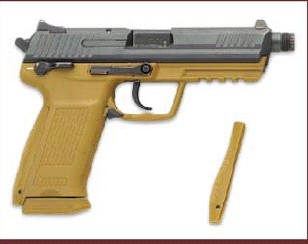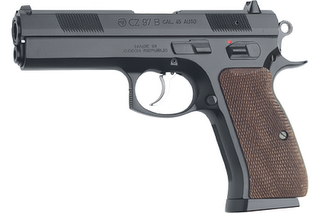The Best 45 Caliber Handguns (non-1911)
The current model M9s (Beretta 92F) were scheduled for replacement under the Future Handgun System, which was merged with USSOCOM's SOF Combat Pistol program to create the Joint Combat Pistol (JCP) program. The JCP winner was specified as having a number of new features; chambered for .45 ACP, an integrated rail, Day/Night sights, and capable of accepting a sound suppressor. In early 2006, the JCP program was renamed Combat Pistol and seemingly split from the Army program.
On March 10, 2006 a modification to the earlier request was made, changing the name from Joint Combat Pistol to Combat Pistol. The number of pistols sought was reduced from 645,000 handguns to 50,000. This basically reverted back to the SOF Combat Pistol program in terms of its scale, as the Army dropped its participation. [1] In Fall of 2006, the Combat Pistol (CP) program was suspended indefinitely.
Many military and law enforcement organizations in the United States continue to use (often modified) M1911A1 pistols because they favor the stopping power of the .45 cartridge and the superior handling of the weapon in close fighting – as tested over the past wars. Marine Force Recon, LA Police SWAT, the FBI Hostage Rescue Team and 1st Special Forces Operational Detachment - Delta (Delta Force) are among the units that use a 45 ACP pistol.
The United States Special Operations Command (USSOCOM) issued a requirement for a .45 ACP handgun (the OHWS trials). This resulted in the Heckler & Koch OHWS becoming the MK23 Mod 0 Offensive Handgun Weapon System.
 On May 1, 1996, the first HK MK 23 pistols were delivered to the US Special Operations Command for operational deployment, making the MK 23 the first .45 ACP pistol to enter American military service since the venerable Government Model 1911A1. This pistol is used by Navy SEALs and the Army Special Forces.
On May 1, 1996, the first HK MK 23 pistols were delivered to the US Special Operations Command for operational deployment, making the MK 23 the first .45 ACP pistol to enter American military service since the venerable Government Model 1911A1. This pistol is used by Navy SEALs and the Army Special Forces.Because of the renewed interest in the 45, I decided to list five top handguns in the market today or soon will be that are non-customized, and are basically off the shelf accessible. I excluded pistols that were high in cost, have a threaded barrel, and are a derivative of the 1911 model.
HK USP (and variants)
 This gun is INCREDIBLY accurate out of the box and completely reliable. One of the most important features of the USP is the mechanical recoil reduction system. This system is incorporated into the recoil/buffer spring assembly, located below the barrel. Designed primarily to buffer the slide and barrel and reduce recoil effects on the pistol components, the system also lowers the recoil forces felt by the shooter.
This gun is INCREDIBLY accurate out of the box and completely reliable. One of the most important features of the USP is the mechanical recoil reduction system. This system is incorporated into the recoil/buffer spring assembly, located below the barrel. Designed primarily to buffer the slide and barrel and reduce recoil effects on the pistol components, the system also lowers the recoil forces felt by the shooter.Pros: Incredibly accurate, very well made, very reliable, very comfortable, light and concealable, can handle .45 super, lifetime warranty.
Cons: INCREDIBLY expensive, HK customer dis-service
The NEW HK45

The new HK45 is based on the proven USP45 family, and refinements of the P2000 series as well. The HK45 design was based on the USP45 because of the reilable design which had proven capable of functioning even without lubricant!
Along with the features on the USP45 and P2000, the HK45 features replaceable backstraps to adjust the size and feel to a shooter's comfort, and a ten round magazine. It sports a five inch barrel , and is designed to handle standard pressure and +P .45 ACP ammunition while having a 20,000 round minimum service life.
Production models should be available late this year or early in 2007.
Sig Sauer P220 (and variants)
 First introduced in the 1970’s, the SIG P220 is one of the best balanced .45's there is. It is a stagger stack design with an 8 round capacity (a 10 round magazine is available); and it is available in nearly a dozen configurations. There is also a compact version (P245) that is well liked for concealed carry.
First introduced in the 1970’s, the SIG P220 is one of the best balanced .45's there is. It is a stagger stack design with an 8 round capacity (a 10 round magazine is available); and it is available in nearly a dozen configurations. There is also a compact version (P245) that is well liked for concealed carry.The company recently introduced five new variations of the P220 .
 They include the P220R DAK, P220 Match, P220R Carry Two-Tone SAO, and the P220R Equinox. The newst version is the P220 Combat, available after August 2006. It was designed to meet, and exceed, rigorous military standards. Each pistol features the military’s Flat Dark Earth finish on its alloy frame and SIG’s Nitron over a stainless slide. Internal parts and controls are coated or phosphated for extreme corrosion resistance and reduced friction while the barrel is hard chromed and finished in Nitron which easily passes the military’s accuracy requirements – even after 20,000 rounds. The P220 Combat also passes the military’s 240-hour salt spray corrosion test. Additional features include a true M1913 Picatinny rail, vertical front strap serrations and SIGLITE® night sights.
They include the P220R DAK, P220 Match, P220R Carry Two-Tone SAO, and the P220R Equinox. The newst version is the P220 Combat, available after August 2006. It was designed to meet, and exceed, rigorous military standards. Each pistol features the military’s Flat Dark Earth finish on its alloy frame and SIG’s Nitron over a stainless slide. Internal parts and controls are coated or phosphated for extreme corrosion resistance and reduced friction while the barrel is hard chromed and finished in Nitron which easily passes the military’s accuracy requirements – even after 20,000 rounds. The P220 Combat also passes the military’s 240-hour salt spray corrosion test. Additional features include a true M1913 Picatinny rail, vertical front strap serrations and SIGLITE® night sights.Pros: Extremely well made, great fit and finish, great balance, very accurate, very reliable.
Cons: Stock magazine only hold 8 rounds.
S&W 990L
 Closely related to the Walther P99, the Smith & Wesson SW99 (introduced in 2005) is a joint venture between S&W and Walther, who produces a modified receiver in Germany, and Smith & Wesson, who fabricates the slides and barrels in the USA. (Walther doesn’t offer a P99 in .45 caliber). It’s a flawless performer, accurate, and comfortable to shoot.
Closely related to the Walther P99, the Smith & Wesson SW99 (introduced in 2005) is a joint venture between S&W and Walther, who produces a modified receiver in Germany, and Smith & Wesson, who fabricates the slides and barrels in the USA. (Walther doesn’t offer a P99 in .45 caliber). It’s a flawless performer, accurate, and comfortable to shoot.When S&W created the new M&P, they took many attributes from the 99 and incorporated them into the M&P.
 The company invested a lot of R&D into the M&P, and when it is offered in the 45 ACP, it will be considered a top three handgun. Click HERE to view the M&P in action.
The company invested a lot of R&D into the M&P, and when it is offered in the 45 ACP, it will be considered a top three handgun. Click HERE to view the M&P in action.Pros: A great combination of American and European gun makers. Well made, great balance, very accurate, very reliable.
Cons: Waiting for the M&P to be 45 ACP.
Glock 21
 I’ve included the Glock because you really can’t ignor it. Because of its large frame size, its grip is too large for many people but is well suited for those with larger hands. The GLOCK 21 has undergone 3 major revisions since its introduction and current models are called 3rd generation GLOCK 21s. I personally don’t like the look of it, its too blocky and needs to revised again.
I’ve included the Glock because you really can’t ignor it. Because of its large frame size, its grip is too large for many people but is well suited for those with larger hands. The GLOCK 21 has undergone 3 major revisions since its introduction and current models are called 3rd generation GLOCK 21s. I personally don’t like the look of it, its too blocky and needs to revised again.Pros: Well made (though often rough always functional), accurate, EXTREMELY reliable, 10rd capacity.
Cons: Rough finish (but tough), heavy, VERY bulky, and slightly unweildy, trigger, plastic, and ugly.
CZ 97B
 Introduced in 1997, this is a big gun, built like a tank with fit and finish like a SIG. Superb accuracy and low recoil (due to its size). Because it was designed around S&B hardballs, there have been some cases of the weapon being ammunition selective, meaning its jams with some hollow point rounds, but once you break it in, this problem should not re-occur.
Introduced in 1997, this is a big gun, built like a tank with fit and finish like a SIG. Superb accuracy and low recoil (due to its size). Because it was designed around S&B hardballs, there have been some cases of the weapon being ammunition selective, meaning its jams with some hollow point rounds, but once you break it in, this problem should not re-occur.Pros: Well made, accurate, great fit and finish, price.
Cons: Selective ammunition.

